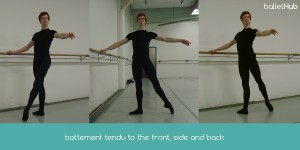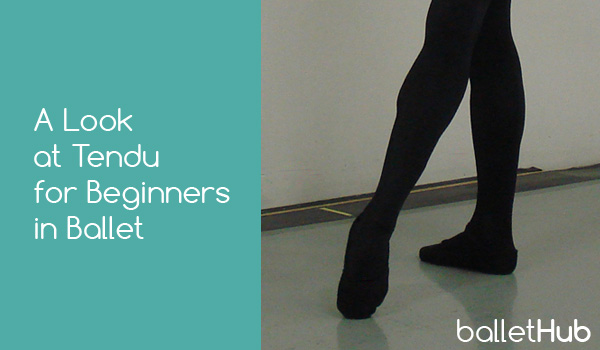Tendu is taught as the action of stretching your leg and foot out from one position to another, while keeping it on the floor. While most teachers may simply say “Tendu…,” the complete term is battement tendu. Tendu literally translates from French as “stretched”. A tendu in classical ballet, outside of a class, is most commonly seen as a preparation for more complex steps such as a pirouette or jump.
Today, we’ll take a basic look at Tendu that is geared for beginners.
A Basic Look at Tendu in Classical Ballet
A tendu, though having checkpoints like going through a demi point both going out and back in, should be a single fluid movement.
You can Tendu from any position really, but its most commonly from one of the four main positions of the feet in classical ballet: first, second, fourth or fifth. A Tendu basically looks like one leg is stretched away from the body, but with the tip of the toes still remaining in contact with the floor as the dancer’s foot arches. In classical ballet, the out-ward stretched leg almost always either to directly in front or back, or side of the dancer.
First, let’s take a basic look at what is done in a tendu from first or fifth position:
 Start in first or fifth position.
Start in first or fifth position.- With your legs already straight with pulled up muscles, push into the floor and out with your outside (away from the barre) leg and foot to the front, side or back. Try to thinking of pushing out with the inside muscles of your leg.
- Continue stretching your leg out until your heel begins to lift while you push into the floor with the ball of your foot, then stretch your foot into a full point. Remember to leave the tip of your toes in contact with the floor.
- Once you’ve reached the full extension of your leg, reverse the process and bring your leg and foot back in to the position you started in.
A tendu, though having checkpoints like going through a demi point both going out and back in, should be a single fluid movement. Try to go through the checkpoints without stopping.
Things to Keep in Mind with Tendu
Like every other step in classical ballet technique, there are some things you should think of doing, but also things you should think of not doing. When doing Tendu, keep the following in mind:
 Try to keep your hip from starting the movement, actively engaging or moving outside its starting position in a Tendu. Think of your muscles moving your leg as opposed to your hip joint. It shouldn’t sink or raise, just remain still.
Try to keep your hip from starting the movement, actively engaging or moving outside its starting position in a Tendu. Think of your muscles moving your leg as opposed to your hip joint. It shouldn’t sink or raise, just remain still.- Try not to confuse “being still” in your hips with gripping the muscles around them. Actually, you want to think of the exact opposite. The more you think of relaxing the hip joint, the more freely your leg can move.
- As you stretch you leg and foot in a Tendu, or more exactly, battement tendu, remember to keep your toes connected to the floor. The moment you lift them off after a full stretch, it’s no longer a battement tendu.
A More Advanced Look
Once you have the basics of battement tendu, we can take a more advanced look at some ideas to move your technique a bit further. There is actually a lot more going on in a tendu than meets the eye, all of which helps provide dancers with a strong base and functional strength in their feet.
In an advanced post, we’ll cover some techniques and methods to get the most out of this basic step which over time, can help your overall ballet technique tremendously.

